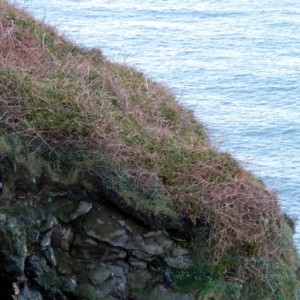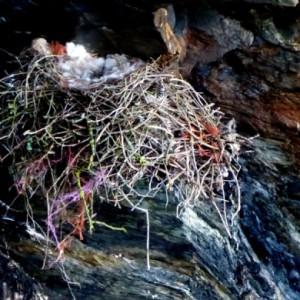Get a nest! (Got it!)
High on the cliff this pair of the kittiwakes* was indulging in a vigorous pas de deux, bobbing and weaving their necks in an amorous, pair-bonding ritual.
I was surprised to read that their eggs (usually 2) will not be laid until May. Nevertheless, like any responsible, far-sighted young couple, they have their nursery ready. Directly below them was a carefully constructed nest that seemed to conform perfectly to established procedure:
"Building the nest in order to welcome their fragile eggs is a tedious task and requires time and energy. The parents begin with a layer of mud and grass in order to form a platform that will cushion and help to isolate the eggs from the cold ground. A cup is then built around the platform in order to keep the eggs from rolling out of the nest. Finally, the nest is lined with soft and dry material such as moss, grass or seaweed. The nest is solidified by a continuous trampling of the materials by the pair. Throughout this period, the male will do courtship feeding by feeding the female at their nest site."
See extras for nest and perching site.
* I may be wrong and these are fulmars. (Thanks gen2!)
In which case it's not their nest. Fulmars don't make nests, they lay on bare rock.
It was interesting to note that colourful strands of plastic had been woven into the structure whether by accident or design I don't know, but the inclusion of some twigs bearing bright yellow lichen made me wonder if these individual touches of colour help the adult birds to recognize their nest among many identical ones. Kittiwakes usually nest in colonies although this one was on its own.
It was a fine day for a coastal walk after a succession of wet misty ones.
Delighted at so many positive responses to the work of Robert Blomfield that I shared yesterday. Thank you so much for the appreciative comments. If anyone missed that I strongly recommended a look.



Comments
Sign in or get an account to comment.


